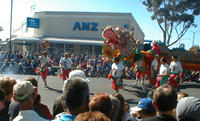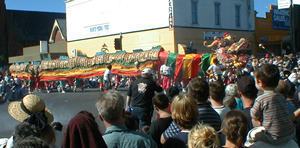Bendigo's YEAR OF THE DRAGON
Source
Unpublished, 2000
 ‘The
best thing is seeing 350 little white faces, all wanting to be Chinese.
And we accept them as Chinese, just as they accept us as Aussies.’
Today thousands will gather to watch Russell Goldfield Jack lead the
colossal dragon on its annual wild dance along Bendigo’s High Street.
Russell Jack, the head dragon-bearer of the Easter Procession, carries
a history that has entwined Chinese and Anglo roots for nearly 150 years.
‘The
best thing is seeing 350 little white faces, all wanting to be Chinese.
And we accept them as Chinese, just as they accept us as Aussies.’
Today thousands will gather to watch Russell Goldfield Jack lead the
colossal dragon on its annual wild dance along Bendigo’s High Street.
Russell Jack, the head dragon-bearer of the Easter Procession, carries
a history that has entwined Chinese and Anglo roots for nearly 150 years.
The first procession was held in 1871 to raise money for the Benevolent Asylum & the Bendigo Base Hospital; it featured ‘celestials’ in a pig race wearing Mongolian costume. Chinese participation quickly evolved into a more serious spectacle, including theatrical dioramas, mechanical figures, automated fireworks, percussion and elaborate traditional costumes—the best show that China could offer. Today, the Chinese component is more than a kilometre long, with nearly 500 participants in oriental costume, 57 of whom are bearing the longest Imperial dragon in the world.
Russ is descended from Kwong Mak Quin, who arrived at the goldfields from Canton in the 1860s and married Marianna Smith in Eaglehawk. Though he anglicised his name to Mark Quin, Russ’ great-grandfather initiated the family tradition of carrying the dragon’s head.
Russ is not the only remnant of goldfield Chinese you can find in today’s Bendigo. You can still visit a Chinese herbalist, eat at the fourth-generation Toi Shan Restaurant and join Buddhist worshippers in the Joss House. During the gold rush, there were up to 5,000 Chinese—a quarter of the Bendigo population. There now remain nearly a thousand of Chinese descent, many in mixed marriages. As well as practical survival, the story of Chinese in central Victoria can sound almost mythical. Consider Pomelo tree.
For overseas Chinese, the Pomelo retains an important link with their homeland. Known as the ‘tree of life’, its leaves are added to the water of a newborn’s first wash. The Pomelo fruit is descended from the grapefruit and can grow as large as a basketball (its name is Dutch for ‘pumpkin-lime’). When Bendigo’s original Chinatown was redeveloped, the community’s one remaining Pomelo clung stubbornly to life in the new car park.
The totalitarian poet Mao Tse-Tung was famous for declaring ‘let a hundred flowers blossom…’ On the other side of the world, Bendigo has taken this literally. The lone Pomelo has been disseminated onto a hundred trees and grafted onto quince stock. At least one Pomelo has gone to every Chinese cemetery in the area.
 The
Year of the Dragon is an auspicious time for the Pomelo. Its leaves
are an essential food for Chinese Dragons and worldwide production is
expected to increase to meet the demands. The tree is especially important
to Bendigo, which has become the world’s main dragon lair.
The
Year of the Dragon is an auspicious time for the Pomelo. Its leaves
are an essential food for Chinese Dragons and worldwide production is
expected to increase to meet the demands. The tree is especially important
to Bendigo, which has become the world’s main dragon lair.
Bendigo’s first recorded dragon was commissioned for the 1892 Easter Procession. As most dragons were destroyed during the Chinese Cultural Revolution, Loong (Chinese for ‘dragon’) is now the oldest dragon in the world. In 1901, it was included in the parade to mark Australia’s Federation and is currently being restored for the parade’s reenactment in May next year. In 1970, Loong was replaced by Sun Loong (new dragon), which is the longest imperial dragon in the world (100 metres in length).
The initial decision of the Bendigo establishment to feature Chinese in their fair was felicitous. Known to the first Chinese as Dai Gum San (Big Gold Mountain), Bendigo was an early beneficiary of their civic responsibility. In 1856, Chinese miners contributed £200 towards a new hospital. In Easter 1898, they invited the public to visit their camp, entertaining the orientalist curiosity about opium dens and exotic ritual. It proved a great success and within eight years there were up to 2,000 Chinese in the Easter Procession. Many more Chinese would come from elsewhere in Australia for annual reunions.
Where are the dragons today? Appropriately, they now rest on the site where the Pomelo once stood. With no ongoing government funding but much determination, the Bendigo Chinese Association established the Golden Dragon Museum in the middle of the old Chinatown. It is now a model for community museums around Australia.
 There
are more awards and medals in this ornate building than the RSL on Anzac
Day. It was the first museum in Victoria to be accredited by Museums
Australia. Sixty-five year old Russell Jack leads the museum with his
trademark energy (he is current holder of Bendigo’s sprint record).
Last year, he received the Museum Industry Recognition Award for substantial
individual contribution (his wife Joan had previously been awarded Museum
Professional of the Year). The dynamic couple combine the Chinese work
ethic with an Australian directness—‘yer can’t take all
the time’.
There
are more awards and medals in this ornate building than the RSL on Anzac
Day. It was the first museum in Victoria to be accredited by Museums
Australia. Sixty-five year old Russell Jack leads the museum with his
trademark energy (he is current holder of Bendigo’s sprint record).
Last year, he received the Museum Industry Recognition Award for substantial
individual contribution (his wife Joan had previously been awarded Museum
Professional of the Year). The dynamic couple combine the Chinese work
ethic with an Australian directness—‘yer can’t take all
the time’.
Success snowballed and their museum is now a cultural complex. Not only does the museum house rare artefacts and display local Chinese history, it also includes an Education Centre (teaching Chinese language and crafts), tea room (Russ and Joan do the cooking, of course), a gift shop that is worth a visit in itself, a work for the dole program, an extensive Chinese Garden and Temple. They have since taken over an adjacent pub and will soon provide accommodation facilities. There are plans for an eight-storey pagoda, each level representing one of the Chinese dynasties.
The Chinese would say that the museum has had a ‘direct rise into the blue sky’. For Russ’, that sky is definitely Australian. ‘Australia is the best country, by a country mile. Here you’ve got blue sky and blue water. Overseas, the sky is brown. The water is brown.’
On its own, this endless scroll of honours can become monotonous. Yet each entry reveals an important new link between Australia and China. Their 1999 award for Best Museum Project adorns an epic tale of cultural exchange, Through the Eyes of Two Cultures, which has the distinction of being the first exhibition of Australian art in Beijing National Gallery. Curated by museum protégé, Raph Beh, it was a collaboration between the Chinese painter Zhou Xiao Ping and Aboriginal artist from Turkey Creek, Jimmy Pike.
For Russ, the key to the longevity of Chinese community in Bendigo is the intrinsic generosity of the Chinese people. ‘It began because they were grateful that Australian gave them a home’. His museum is testimony that this philanthropy continues, though it sometimes needs a little reminder. Like a country football coach, Russ continues to lecture the community about its obligations: ‘I hammer ‘em a bit. Doesn’t matter if you’re black, white or brindle, you belong to the human race. You’ve got to give something back to it.’
Xiao Ping is just one of many artists who now use Bendigo as a gateway to China. The painter Janenne Eaton was part of a cultural exchange developed by Westspace gallery. In a Hong Kong Gallery called Parasite, she exhibited work featuring the names of Chinese whose bodies remain buried in Bendigo. Her show attracted much interest in a city rediscovering its own historical roots.
She recalls visiting Bendigo’s Golden Dragon Museum just before leaving for China. A mysterious old Chinese man approached her when she was leaving and insisted she take a little paper crane for her good fortune. The origami seemed to do its trick—the old man’s family performing similar services for generations. It was his mother who nurtured the Pomelo tree that once grew on the site of the museum. And it is his younger brother, Russ, who now runs the museum with his wife Joan.
According to the current logic of globalisation, big cities get bigger and the small cities get smaller. Bendigo defies this logic, by means that are more mythical than macroeconomic. Like the old Pomelo tree, the Chinese roots in Bendigo are deep and entangled with English stock. Its fruit develops more flavour every year.


Copyright held by author Kevin Murray
For permission to reproduce this article, please contact Kevin
Murray